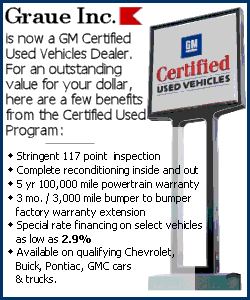 "We've always taught parents how to keep their kids safe, but this
report highlights precisely when and why those precautions are
essential," says Kim Escobedo, chapter coordinator for Safe Kids
Logan County. "Understanding children's cognitive, behavioral and
physical abilities and limitations at various stages is the first
step in being able to foresee and prevent serious injuries." "We've always taught parents how to keep their kids safe, but this
report highlights precisely when and why those precautions are
essential," says Kim Escobedo, chapter coordinator for Safe Kids
Logan County. "Understanding children's cognitive, behavioral and
physical abilities and limitations at various stages is the first
step in being able to foresee and prevent serious injuries."The
end of April is National Safe Kids Week, recognized on the HOPE
Mobile all month with educational information plus drawings for a
kid's bicycle helmet, donated by Safe Kids, and a car seat, made
possible by the Illinois Department of Transportation. There will
also be 25 water test kits available first-come, first-served for
testing ground and well water. These will test for coliform
bacteria, E. coli and nitrates. Sampling is always free for
households that use a well and have an infant in the home.

The Logan County Department of Public Health offers checking of
car seats every Monday by appointment and has discounted seats
available for income-qualifying clients. The seats were provided by
a grant from the Illinois Department of Transportation.
According to the Centers for Disease Control and Prevention, in
2007 children ages 0-14 had more than 6 million unintentional
injuries that required care in an emergency room. This translates
into 12 injuries per minute -- nearly all of which are preventable.
Although the childhood injury death rate in the U.S. has dropped by
45 percent in the 22 years Safe Kids has been in operation,
unintentional injury remains the leading cause of death and
disability in children ages 1-14 in the U.S.
The release of the recent report, "Raising Safe Kids: One Stage
at a Time," coincides with the kickoff to National Safe Kids Week
and is based on an extensive literature review of research focusing
on child development as it relates to unintentional injury. The
report is divided into four stages of development: infancy, 0-12
months; early childhood, 1-4 years; middle childhood, 5-9 years; and
early adolescence, 10-14 years.
For each stage, the report includes a description of a child's
development at that age and easy-to-follow safety tips for the five
leading injury risks to children: falls, bicycle-related injuries,
motor vehicle occupancy injuries, fire and burns, and poisonings.
Some highlights from the report:
Did you know that infants have spines that are not fully
developed, leaving them vulnerable to injury if they are not
correctly positioned in a vehicle? They have a slower digestion rate
and a lower tolerance for medication. Their skin is thinner and more
sensitive, meaning it can burn more quickly than that of an adult.
To keep your infant safer:
-
Use a rear-facing,
semi-reclined car seat until your baby is at least age 1 and 20
pounds. Use a rear-facing car seat longer if the seat has higher
weight and height limits.
-
Always follow
directions and read labels when giving your baby medicine, to
avoid overmedicating.
-
Do not hold an infant while cooking or
carrying hot liquids and foods.
Did you know that children 1-4 years old have muscles and bones
not yet fully developed? They are also still learning how to balance
themselves and adjust their stance to avoid falls. They may wander
off unsupervised to explore cupboards and drawers that may contain
chemicals and poisons.
To keep your 1- to 4-year-old safer:
-
Provide safe
places to play. Only allow your child to play on playgrounds
with 12 inches of safe surfaces such as shredded rubber,
hardwood fiber or fine sand below the equipment to create a
softer landing in case of a fall.
-
Install stair
gates so your curious child will not fall down stairs, and
secure furniture to the wall to avoid it tipping over on them if
they try to climb on it.
-
Keep medicines and poisonous household
items locked up and out of reach. Also, choose products with
child-resistant packaging.
[to top of second column] |

Did you know that children 5 to 9 years old have trouble recognizing
and avoiding obstacles and lack an adult's hand-eye coordination
abilities? They are also at higher risk for cooking-related scald
injuries, especially from tableware and microwave ovens. If a child
is too small for a seat belt, he or she is at risk for serious
injuries to the head, face and internal organs.
To keep your 5- to 9-year-old safer:
-
Make sure children
wear a helmet and protective gear every time they are on wheels.
-
Do not allow
children to use a microwave until they are tall enough to reach
the items in it safely and understand that steam can cause
burns. Children at this age are at a higher risk of
cooking-related scald injuries than adults.
-
Keep children in booster seats with the
vehicle lap and shoulder safety belts until the seat belt fits
correctly.
Did you know that early adolescents have less defined visual
perception than older teens and lack the ability to recognize a
specific object from within a busy background? This is an important
skill to identify oncoming cars in busy intersections. They are more
likely to be completely unrestrained in a car than younger children
and to participate in risky behavior. They also may want to
experiment with substances without adult supervision.
To keep your 10- to 14-year-old
safer:
-
Make sure your
child wears a helmet and protective gear every time he or she is
on a bike, scooter, skateboard or inline skates. Make this
non-negotiable and lead by example.
-
Talk to them about
car safety. Once your child passes the safety belt fit test,
teach him or her to wear a seat belt every time.
-
Talk to your child about the dangers of
poisonous items such as gasoline, spray paint and medicines.

"Your child's physical, behavioral and cognitive abilities should
affect the precautions you take to help them avoid serious injury,"
Escobedo said. "Serious injuries have effects lasting well into
adulthood, such as spinal cord injuries and brain damage, which also
lead to costly emergency department bills, missed school days and
limited future employment opportunities. But the good news is, these
injuries can be prevented if parents and caregivers take the right
steps."
For more information about Safe Kids Week, call 217-735-2317 or
visit www.lcdph.org and click on
the Safe Kids icon.
Safe Kids Logan County works to prevent unintentional childhood
injury, the leading killer of children 14 and under. Its members
include Community Child Care Connection, Lincoln Parents' Center,
CIEDC and Abraham Lincoln Memorial Hospital. Safe Kids Logan County
is a member of Safe Kids Worldwide, a global network of
organizations dedicated to preventing unintentional injury. Safe
Kids Logan County was founded in 2003 and is led by Logan County
Department of Public Health.
[Text from
Healthy
Communities Partnership file]

 |